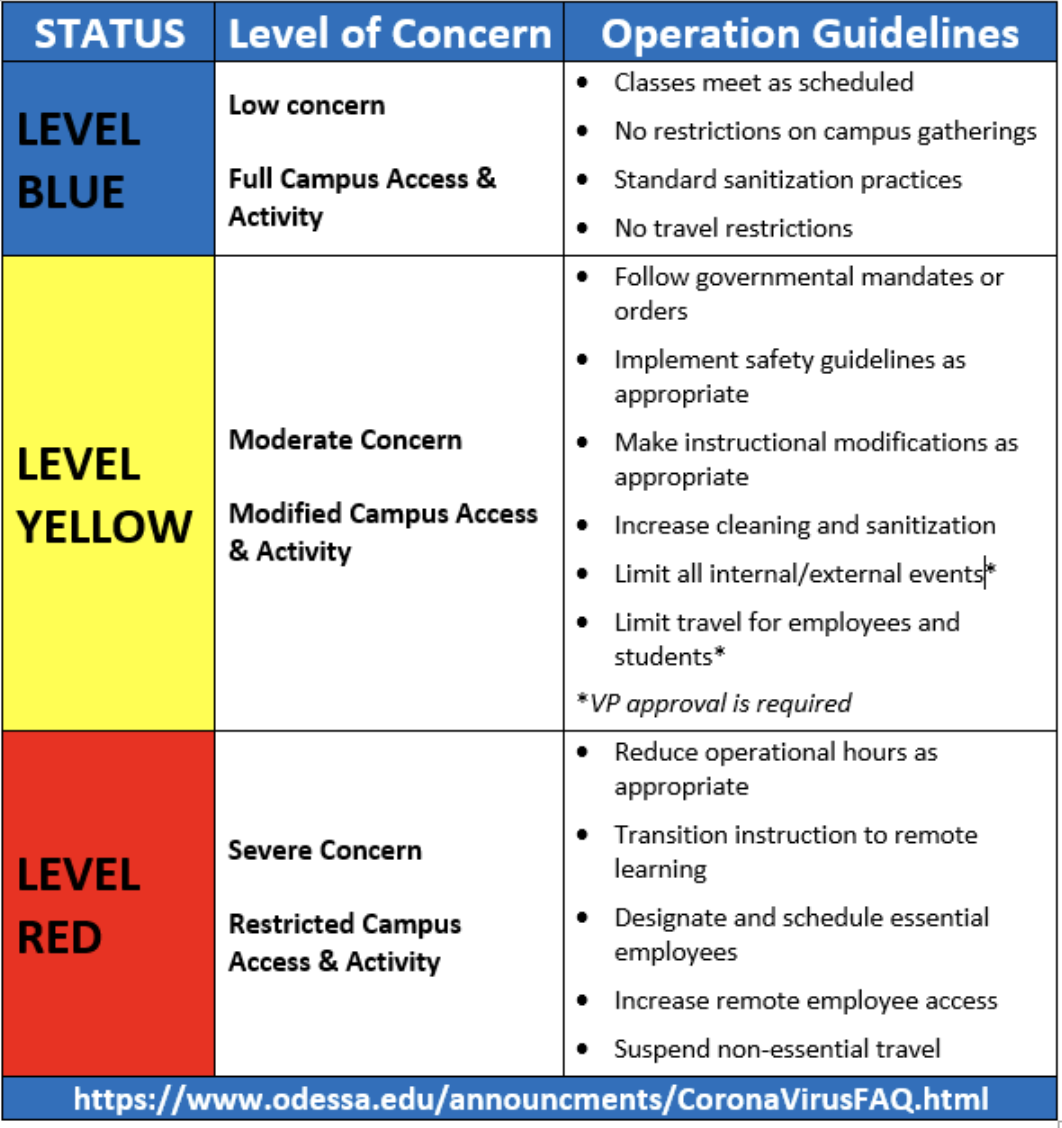
COVID-19 INFORMATION & RESOURCES
Emergency Operations Protocols & COVID-19 | September 9, 2022 – In March of 2022 Odessa College transitioned to color code/level BLUE of the Emergency Status Operations Protocol. Per Texas Department of Health Services, public schools are no longer required to report positive COVID-19 cases on school campuses. Effective September 9, 2022, Odessa College will suspend the current COVID-19 protocol including updates to the dashboard and distribution of timely warnings due to exposure.
Please use the helpful CDC RESOURCES and LINKS below. The quarantine and isolation calculator and subsequent guidance are consistent with the college’s COVID-19 protocol:
Odessa College will continue to prioritize your education and your health. Please be prepared to transition to increased restrictions should COVID-19 cases in the region rise.
Emergency Operations Protocols & COVID-19 | August 19, 2022 – In March of 2022 Odessa College transitioned to color code/level BLUE of the Emergency Status Operations Protocol. While we remain in level blue, the county, the state and the nation have experienced an increase in reported cases of COVID-19 this summer. Employees, students, visitors and vendors who test positive for COVID-19, or present with new or worsening signs or symptoms associated with COVID-19, should complete the Odessa College COVID-19 Reporting Form.
Odessa College will continue to prioritize your education and your health. Please be prepared to transition to increased restrictions should COVID-19 cases in the region rise.
Please use the helpful CDC RESOURCES and LINKS below. The quarantine and isolation calculator and subsequent guidance are consistent with the college’s COVID-19 protocol:
- Odessa College COVID-19 Reporting Form
- Odessa College COVID-19 Dashboard
- COVID-19 Quarantine and Isolation Calculator
- COVID-19 by County
- About COVID-19
MONKEYPOX INFORMATION & RESOURCES
Monkeypox is a rare disease caused by infection with the monkeypox virus, according to the U.S. Centers for Disease Control and Prevention (CDC). Monkeypox comes from the same family of viruses that cause smallpox, and while monkeypox symptoms are similar to those of smallpox, it is milder and rarely fatal.
If you have symptoms of monkeypox, you should avoid direct, close contact that can spread the disease, and talk to your healthcare provider, even if you don’t think you have had contact with someone who has monkeypox. Students must contact the Vice President of Student Services at kmckay@odessa.edu or 432-335-6770 to begin the isolation protocol. Employees should notify Human Resources and contact their personal healthcare provider.
The CDC, the Texas Department of Health and local health officials continue to monitor closely the spread of monkeypox; 1,079 cases were confirmed in Texas in August 17, 2022.
HOW MONKEYPOX SPREADS
Monkeypox can spread to anyone, most often through close, skin-to-skin contact, as well as:
- Direct, close contact with monkeypox rash, scabs, or body fluids from a person with monkeypox.
- Touching objects, fabrics (clothing, bedding, or towels), or surfaces that have been used by someone with monkeypox.
- Contact with saliva or respiratory droplets from someone with monkeypox.
MONKEY POX SYMPTOMS
Monkeypox symptoms usually start within 3 weeks of exposure to the virus.
- Symptoms can start with fever, headache, muscle aches, swollen lymph nodes, chills, or exhaustion.
- After flu-like symptoms, a rash appears that can look like pimples or blisters.
- Monkeypox can spread from when symptoms start and until the rash has healed and fresh skin has formed, which can take several weeks.
HOW TO PREVENT MONKEYPOX
Take the following 3 steps to prevent getting monkeypox:
1. Avoid close, skin-to-skin contact with people who have a rash that looks like monkeypox. a. Do not touch the rash or scabs of a person with monkeypox. b. Do not kiss, hug, cuddle or have sex with someone with monkeypox.
2. Avoid contact with objects and materials that a person with monkeypox has used. a. Do not share eating utensils or cups with a person with monkeypox. b. Do not handle or touch the bedding, towels, or clothing of a person with monkeypox.
3. Wash your hands often. a. Wash your hands often with soap and water or use an alcohol-based hand sanitizer, especially before eating or touching your face and after you use the bathroom.
Although monkeypox is not a sexually transmitted infection, it can be spread through sexual contact.
The CDC offers additional tips on preventing monkeypox through safer sex and safer social gatherings.
MONKEYPOX VACCINATION
Monkeypox vaccines are available and are being delivered to local health departments and DSHS public health regions across Texas.
- Please contact your local health department to learn more about vaccine availability in your area.
- People with a known or possible exposure to the monkeypox virus are the highest priority for vaccination.
- Monkeypox vaccination may protect you from getting sick if given before or soon after your exposure.
Find more information about the monkeypox vaccination.
RESOURCES
Isolation and Prevention Practices for People with Monkeypox

